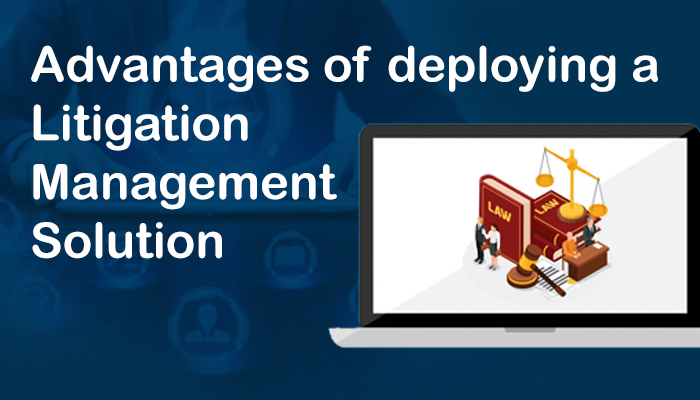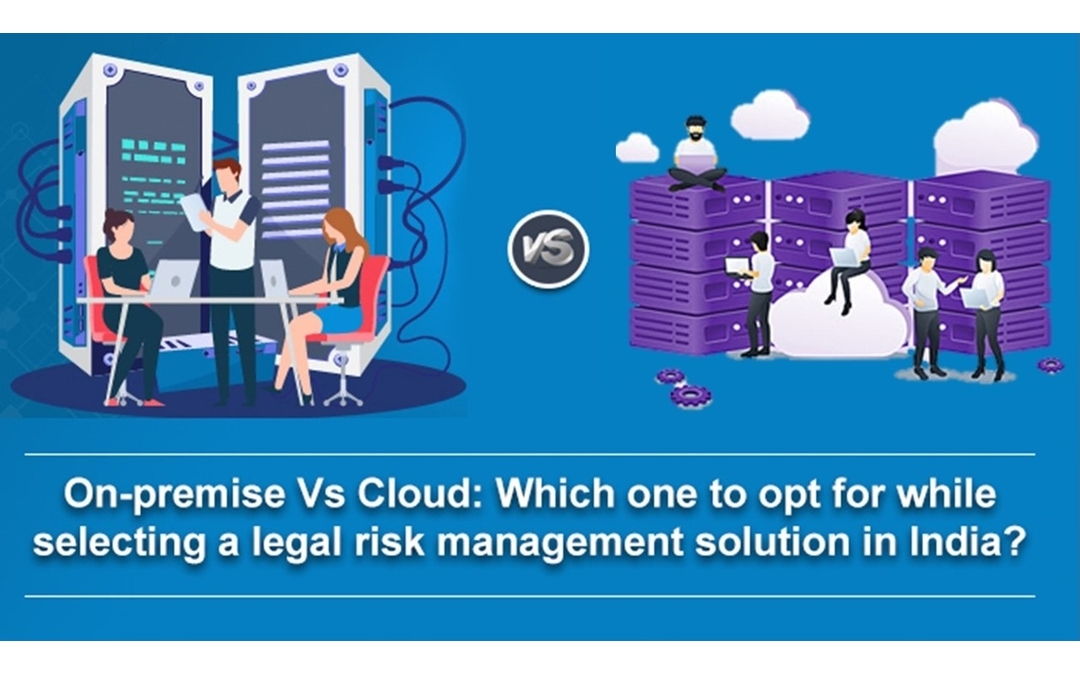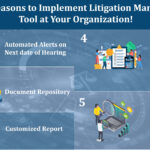Litigation Management by itself, is a complex affair. And the higher the volume of dispute matters, the complexity is also increased. From keeping track of multiple hearing dates across numerous forums, managing voluminous case documents, tracking and responding to notices within timelines, from preparing replies, forecasting potential liabilities and managing budgets (especially overshoots) to documenting/updating interactions with internal stakeholders and external lawyers, the activities required under appropriate litigation management are varied, vast and can be cumbersome. Add to this the complexity of regional languages and you will begin to understand the practical challenges involved.
Now imagine doing all this manually, and at an individual level!
Litigation management not only requires large amounts of planning, time and energy, but also ends up placing excessive demand on (the already scant) available resources and thereby has the potential to introduce opportunities for errors and misses. This in turn increases the legal risk of the organisation. Quite frequently, we see citations of companies facing harsh judgments and costs, due to avoidable procedural misses.
The fledgling legal tech sector promises to deliver software driven solutions for helping organisations better manage the risk arising from their litigation portfolio. Litigation management systems, in India and around the world, are creating a niche legal services delivery model for themselves. These solutions help automate most of the linear, repetitive and manual functions/activities, and thus can go a long way in aiding organisations to better manage their litigation/disputes portfolio, and consequently the risk arising from it. Today, the market is now flooded with generic and specialised litigation management solutions of all functions, shapes, sizes (and even colours).
In light of this, have you considered restructuring your organisations litigation management process? Keep reading to learn more about litigation management software tools and how they can benefit you and your company.
What is a Litigation Management solution?
A Litigation Management (often also referred to as case management or dispute management) Solution is essentially any software solution that enables in-house legal teams and other legal professionals to track, organize, monitor and report on the various nuts and bolts of their litigation portfolio in an efficient and resource-saving manner.
These tools automate most of the tasks involved in managing the disputes portfolio and provide detailed data and analytics on case metrics and user activity, which in turn, can enable the organisation to take important decisions on their disputes portfolio.
What are the ideal features of a Litigation Management solution?
An ideal litigation management solution should have features that enable
- person-independent workflows,
- automation of routine and repeated tasks,
- reduction of human intervention for updating,
- reporting on crucial performance and financial metrics and
- users to operate from any place (whether home or office, while working or on leave/travelling).
Some of the most important features we believe every litigation management solution should have are:
a) a centralised repository for all legal and case documents and connected documents such as emails, internal notes/approvals, opinions, research material and so on;
b) efficient workflows for consolidated case management, task management and tracking/escalating important dates;
c) customisable reports of individual cases and the entire portfolio along with forecasts of potential risk areas;
d) an efficient task management system;
e) an organised and auto-updated list of important contact details of advocates/counsels, witnesses and internal stakeholders
f) multiple types of users with varying access rights;
g) a summary of fees and expenses providing insight into amounts already paid or pending, expenses split by court fees, counsel fees and miscellaneous and more;
Additionally these solutions must also adhere to the latest data privacy and data security standards.
So as we can see, litigation management solutions/tools provide an array of features that enable better management of the litigation portfolio and thereby aid in reducing the legal risk arising therefrom.
Let us now take a look at the benefits.
What are the Benefits of using Litigation Management solution?
1) Optimisation: Through the use of Litigation management solutions, you can optimise and prioritise matters as per their importance and urgencies. They also provide a platform for all your matters to be stored at one place. No more hunting for old files or notes!
2) Time and cost saving: Through the use of efficient task management workflows, centralised repository of documents and customisable reports, litigation management solutions automate and streamline physical and time consuming activities, enabling legal teams to free up their time to focus on more critical issues. Needless to mention, any time saving may also translate to cost-saving.
3) Reduction of human Error / Omission: By reducing multiple, repetitive physical activities (such as storing files, keeping track of and updating dates, compiling reports, looking for templates and research material), litigation management tools reduce the room for human driven errors and omissions that are commonly caused by such activities.
4) Better utilisation of resources: An oft overlooked consequence of the built-in analytics and detailed reporting of these solutions, is to provide in-house legal teams with high level views of resource utilisation – from a personnel, financial and time point-of-view. With data points such as current/ pending workload of individuals and teams, time spent on assignments and matters, log of upcoming assignments and status of completed ones, leaders can assess/review current situations and take necessary action for the optimal usage of available resources. Real-life examples include:
a) Checking individuals calendars to see their available time;
b) Checking billing and expense reports to assess cost/benefit of external counsel;
c) Assessing internal and external stakeholders performance based on timely completions and delayed ones and success/failure ratios;
d) Settling/withdrawing matters which have low victory percentage;
5) Security and peace of mind: One of the biggest concerns for any organisation is potential loss or leak of data, especially when it comes to sensitive legal disputes. Litigation management tools take away those exact uncertainties when it comes to data breach. With most of the solutions today having high end encryption standards, customisable access controls and multiple authentication formats, you can be assured that your data will be safer than elsewhere.
Yes, it is fair to say that Litigation management systems, whilst being fairly new in the market, are receiving increased attention. Disputes have always been one area where “physical” intervention mattered more. Stepping into the post pandemic world, where even court hearings are now moving online, the “pen and paper” is taking a backseat as such solutions are helping firms manage their disputes in the most efficient way.
What is the Future of Litigation software solutions?
Case management software has enabled companies to handle a large number of matters at a time, efficiently and with relative ease. Not only can users stay on top of hearing dates and tasks but organisations can track billing, status of ongoing cases in courts and arbitration awards, and various other metrics. Also the added benefit of having structured data to analyse which can provide valuable insight on fine-tuning the organisations dispute strategy and the respective teams operations. Some of the advances in litigation management software, that we are likely to see in the future are:
a) Integrated and remote resolution of disputes, with courts and other forums moving online;
b) “Smart” review of documents to enable automatic discovery and summary of evidence documents;
c) “Smart” research based on case metrics, causes of action, adjudicating forums;
d) Predictive analytics of case win/loss percentage based on available and past data;
e) Integration with all types of court websites to enable instant and accurate updating of records;
f) Immediate alerts in case of conflicts, changes in judges, benches or even court procedures;
g) “Smart” analysis of case metrics based on changes in legal provisions or recent precedents;
h) Automatic and immediate translation of documents from vernacular to English and vice-versa;
i) Court Intelligence to suggest appropriate forums, time of filing (and perhaps even the best counsel to engage) to ensure highest success rates in matters;
j) Suggesting changes/corrections, based on data, in business operations to avoid potential disputes;
k) Suggested drafts of plaints and other court documents for enabling effective pleadings;
l) Interoperable systems that can link and predict potential disputes from compliance and contracts;
And much, much more.
For more information on litigation management solutions or to learn how it can help at your organisation, please click here or drop us a line at inquiries@lexplosion.in. You may also find out more about Lexplosion Solutions’ very own litigation management solution here.
Written by: Anchal Sharma
Edited by: Agnishwar Banerjee
Disclaimer
All material included in this blog is for informational purposes only and does not purport to be or constitute legal or other advice. The Blog should not be used as a substitute for specific legal advice. Professional legal advice should be obtained before taking or refraining from an action as a result of the contents of this blog. We exclude any liability (including without limitation that for negligence or for any damages of any kind) for the content of this blog. The views and opinions expressed in this blog are those of the author/(s) alone and do not necessarily reflect the official position of Lexplosion. We make no representations, warranties or undertakings about any of the information, content or materials provided in this blog (including, without limitation, any as to quality, accuracy, completeness or reliability). All the contents of this blog, including the design, text, graphics, their selection and arrangement, are Copyright 2018, Lexplosion Solutions Private Limited or its licensors.
ALL RIGHTS RESERVED, and all moral rights are asserted and reserved.





